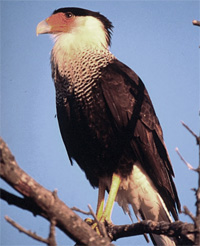 This
part of Mexico has some of the most varied habitats in North America,
from the Madrean Conifer Forests at 8,000 feet on the canyon rims to
sub-tropical areas in the canyon bottoms. With four distinctly different
Biotic communities there is a wide diversity of flora and fauna. This
is especially true with respect to bird life.
This
part of Mexico has some of the most varied habitats in North America,
from the Madrean Conifer Forests at 8,000 feet on the canyon rims to
sub-tropical areas in the canyon bottoms. With four distinctly different
Biotic communities there is a wide diversity of flora and fauna. This
is especially true with respect to bird life. California Native trips through Copper Canyon travel through all four Biotic communities and participants see a great variety of birds. There are at least 270 species found in the region, many of which cannot be found in the United States.
Traveling on the Copper Canyon train you can see Black-throated Magpie Jays, Mourning and White-winged Doves, and Vermilion Flycatchers. On the tops of the Organ Pipe cactus perch Black vultures, with their wings out-stretched to catch the warming rays of the rising sun, and Crested Caracaras, the bird depicted on the National Emblem of Mexico.
At Divisadero, “The Viewpoint“, where a breath-taking view overlooks the deepest part of the canyon, Barn Swallows, White-throated and Black Swifts soar over the canyon rim and walks through the surrounding woodlands turn up exciting birds like Blue-throated and Magnificent hummingbirds, Zone-tailed Hawks, and Hairy Woodpeckers. One time we watched a flock of about a dozen rare and endangered Thick-billed parrots fly by just below the rim of the canyon, right in front of our hotel.
At Lake Arareco, not far from the small town of Creel, are various types of waterfowl including Buffleheads, Ring-necked ducks, Blue-winged teals and even an occasional Osprey. A hike to Cusarare Falls brings sightings of Mexican Chickadees, Red-Faced Warblers, Brown Creepers, White-eared Hummingbirds, Dippers, Belted Kingfishers and the rare and elusive Eared Trogon, probably the most beautiful bird of the area.
In the semi-tropical habitat at the bottom of the canyon, at Batopilas, an entirely different array of birds can be seen. Broad-billed, Berylline, Violet-crowned and Lucifer hummingbirds frequent the many flowers. In the fruit trees are Orioles and Tanagers. Along the riverside Riparian areas there is always the chance to see White-fronted and Lilac-crowned Parrots and Elegant Trogons.
One time while visiting the ancient Cathedral at Satevo, 3 miles down river from Batopilas, I looked up to see three Military Macaws flying near by. These large beautiful green and blue parrots are at the most northern part of their range and seeing them is a memorable experience.
With its close proximity to the U.S. and unique blending of varied habitats, Copper Canyon affords a great opportunity to see many unique bird species while at the same time enjoying the spectacular scenery of the Sierra Madres.
Chuck is a Biologist and professional nature photographer. His articles and photographs have appeared in many magazines and publications including Arizona Highways, Birder's World, and Wild Bird. His areas of specialization have led to his work on many diverse projects including his role as a birding consultant for the Nature Science Network. He has been a guide for California Native since 1990.
Click Here for information on our Copper Canyon Tours.


